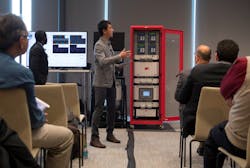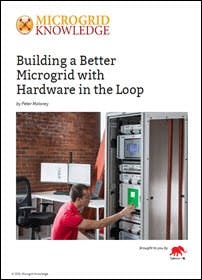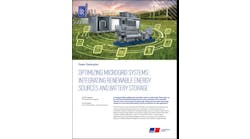The last entry in a new Microgrid Knowledge special report, released in partnership with Typhoon HIL, highlights how microgrid developers can use Hardware-in-the-Loop testing throughout a microgrid’s lifecycle, not just during the design and construction phase.
Download the full report.
Verification of protection coordination
Hardware-in-the-loop testing is a valuable tool in product development, but it can also be used in many other phases of a project’s life cycle. As already discussed, HIL can de-risk the development process by compressing the time needed for design iteration. It can be used before a controller is actually manufactured, and it can be used to test a new product.
Investors are more likely to sign off on the financing of a novel microgrid installation if it’s vetted through rigorous real-world simulation. So HIL testing may be used to demonstrate to potential financiers the viability of a product both on its own right and in matrix.
“Before HIL systems were available, you could do software development, but you couldn’t actually do any performance verification or validation testing, until hardware was available for you to test on. Or you had to develop your own system, which is a significant cost.” — Ryan Smith, chief technology officer, EPC Power
Once past development and funding, Hardware-in-the-Loop testing technology comes into play in operation and maintenance of a microgrid; it provides what-if scenarios and stress tests that can help ensure the readiness of the system. HIL’s flexibility and utility at all stages of a product lifecycle makes it useful to a wide variety of stakeholders, among them:
- Standards boards seeking to draw up, codify, and validate relevant industry standards for new technologies. HIL testing of various technologies and system configurations under a broad range of situations can be a powerful method to help streamline chronically long development processes.
- Regulators who have a stake in understanding the application of MBE and HIL and the results they yield. HIL testing can be used to improve grid interconnection requirements regulators place on projects by virtue of more extensive scenario-based testing. Such testing could even be specified as part of the approval process, as a supplement to more generic design standards.
- Vendors seeking to vet potential products and to demonstrate their performance to potential customers. HIL testing can help expedite the testing and certification processes for individual component technologies (e.g. inverters, relays, controllers etc.). When it comes to making a project a reality, developers and engineering-procurement-construction (EPC) contractors can use MBE and HIL to test and verify components of a microgrid before full integration and synchronization.
- Operators who need to guarantee smooth microgrid operation for the next 20 years as the technologies are evolving, firmware and software are changing, and new components need to be integrated into the existing microgrid. The HIL based digital twin can be used as a reference model against which all the changes, upgrades and updates will be verified.
- Financiers and insurers who need to understand the risks of project performance, both how the system will perform and how much it will cost to build and operate, look for verifiable data, especially for projects that employ new technologies. Without independent verification of performance, investors are often reluctant to lend or will likely increase rates and fees to cover higher perceived levels of risk.
“HIL Testing is being able to give the customer an idea what kinds of applications they are able to have on their site and to demonstrate them easily in the simulation.” — Qiang Fu, regional technology manager, EATON
Looking to the future
So far, MBE and HIL have focused on developing and bringing products to market. However, the same capabilities that cut time and costs from development and production phases, can also be used throughout a product’s life cycle.
In the context of a microgrid, MBE and HIL offer benefits during the useful life of a project. The components of a microgrid will have to work together for 20 or 30 years. There are likely to be multiple software upgrades over that time frame. Every time the software on one component is upgraded, the operator has to be sure that the whole system is still working correctly. HIL allows the components to be tested independently and as part of the system before bringing the system back online.
MBE also has potential for use in predictive maintenance and training. Automated systems can compare predicted and actual behaviors, helping to quickly identify problems and solutions. By running low probability-high impact scenarios, a microgrid operator could prepare employees and the system for potential natural disasters or cyber-attacks. As a training tool the HIL testbed can replicate scenarios that operators would not normally encounter—or would not want to replicate in the real world—as a way of preparing staff for unforeseen events. And as new components and technologies become available, a new generation of smart solar inverters, for example, HIL can be used to test the component and its interoperability with the rest of the system before plugging it into an existing, real world system.
“We HIL-test relays, we HIL-test microgrid controllers, we HIL-test our security systems, we HIL-test communication systems– across the board.” — Scott Manson, technology director, Schweitzer Engineering Laboratories
Because MBE already operates in a digital environment, it is also well positioned to adapt as digital tools evolve. The cutting edge of automation is machine learning, but as the pace of development continues to accelerate, machine learning will likely become more mainstream. Being able to develop and test components and systems electronically will become even more critical as those components and systems become more intelligent. HIL can provide an infinite pool of high-fidelity data and operational scenarios that can be used to develop and test machine learning and AI algorithms. Simply put, new self-learning and adaptable control schemes need to be put in the loop with HIL so they can train and improve at the fastest possible pace.
HIL and microgrid development
As the electric power grid continues to evolve and becomes more agile and complex, the arguments in favor of MBE and HIL become more compelling. This is especially true when it comes to microgrids.
If the aim of a decentralized and digitalized grid is reliability and resilience, the digital tools used to design, test and integrate the components to achieve that end should be no less rigorous and up to date. Model Based Engineering, and especially C-HIL, represents the state-of-the-art approach to link value assessment, engineering, and system operation.
Further more, it becomes a significant tool in speeding up de-carbonization of the human impact on the environment.
The Microgrid Knowledge series on new microgrid simulation and testing techniques also previously covered the following topics. Catch up on the series below:
- New Microgrid Simulation, Testing Techniques Pave Way for Future Microgrids
- Microgrid Testing in Real Time Helps Developers Avoid Risk & Perfect Projects
- Using Hardware in the Loop to Create a Microgrid Testbed
Download the full report, “Building a Better Microgrid with Hardware in the Loop,” free of charge courtesy of Typhoon HIL.








